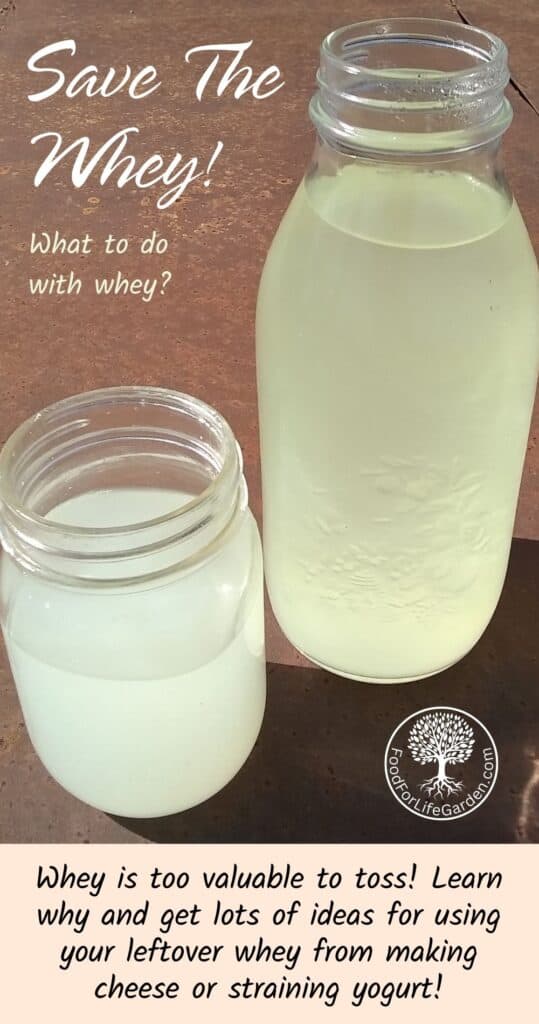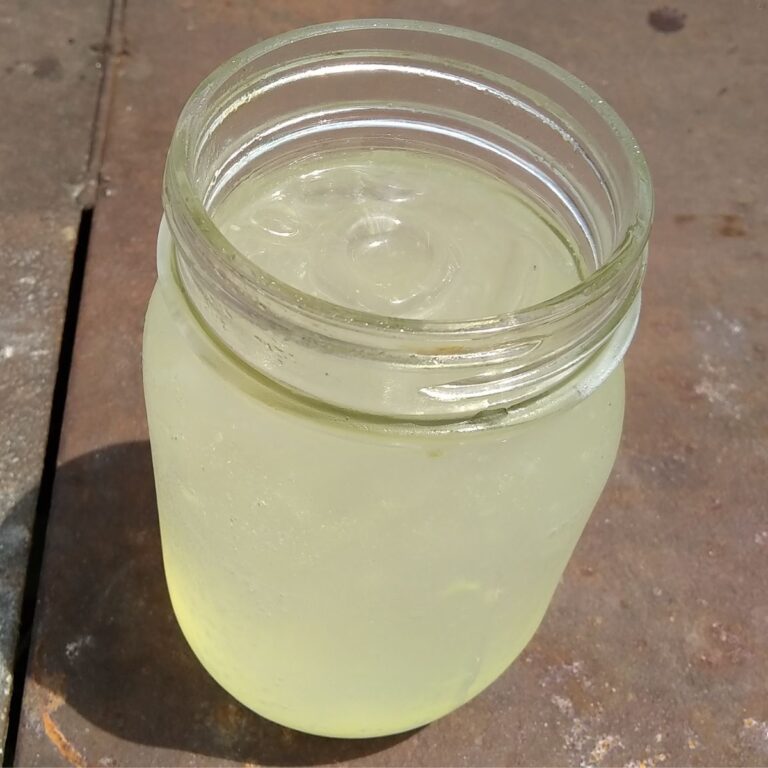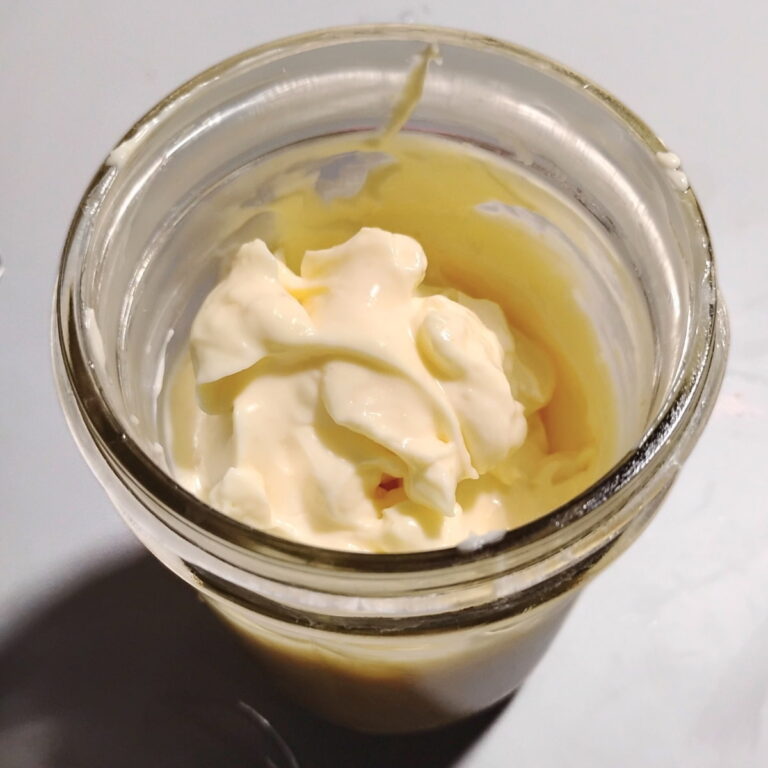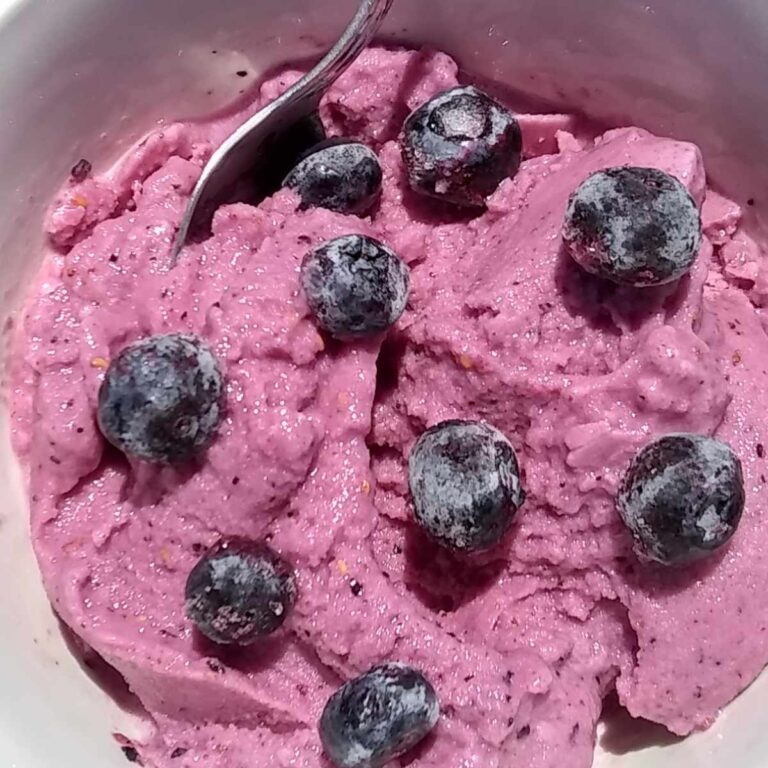Uses for whey. Find value in every single drop. Whey deserves highest ratings and a prominent place in anyone’s natural food kitchen.

This post contains affiliate links, which means I make a small commission at no extra cost to you. If you click through and make a purchase you will help support my small business. See my full disclosure here.
Hello there! If you found this page, you’re probably faced with the ‘dilemma’ of leftover whey and what all to do with it. Whey results from straining yogurt, quark cheese, other hard and soft cheese, or other coagulated and strained milk products such as clabber cheese.
It’s a blessing of a dilemma to have, indeed. And I’ve put together a list of many uses for this precious liquid that remains after you strain out the solids.
It is often assumed that the benefits are in the solids and that the watery whey is just a nutritionally empty by-product that can be discarded.
But to the contrary, whey is full of nutrients and health benefits and it would be a shame to flush it down the drain. Besides, doing so is actually bad for the environment. So let’s not do that and take advantage of all the goodness that whey has to offer.
Here is your first idea: If you’ve got whey, use it as a starter culture to make Fizzy Lemonade or a beautiful deep red, Naturally Carbonated Hibiscus Soda!
If you want to make whey, make some cheese! Check out my popular cheese recipes: How to make Chevre Cheese from goat’s milk, make Clabber Cheese, the original cheese, try making an easy German Quark Cheese, brine-aged Sirene (Bulgarian Feta), and a super quick and easy Queso Fresco! Here is how to Make Cheese With Sourdough Starter. Make whey naturally without raw milk.
Jump ahead to Uses For Whey
- Uses for Whey deserves its own page!
- Save the Whey!
- Properties and Health Benefits of Whey
- Some important aspects to keep in mind about using whey:
- Uses for Whey
- How to store the whey
- If you find whey valuable for daily use, make clabber regularly
- My favorite literary resources that cover uses for whey:
- Other recipes you might like:
- Pin This Recipe For Later
- Shop This Post
Uses for Whey deserves its own page!

Over the past months while writing about cheese, I’ve been tucking little notes about uses for the whey here and there into my various cheese posts.
But I’ve come to realize, that it would be much better, to just devote a page to it, that I can easily update as I think of or find new ways to use whey. And it will keep my other posts more to the point. Now I will just link to this page with regards to whey.
Save the Whey!
Whey is a big part of cheese making, it’s the biggest, actually, volume-wise. And draining even smaller batches of cheese, yields plenty of it.
So it’s a good idea to have in mind some ways to use it. Definitely do not dump it! It deserves to be treated as the other part of the milk in its own right, not as the discard.
Always save your whey! It’s ‘whey’ too precious to dump!! (I know, this pun is ‘cheesy’! 🤣)
Properties and Health Benefits of Whey
Whey is praised by many health practitioners, and I’ve collected a few points here of what experts consider are the benefits of whey.
If you’re taking dietary supplements, you might find that some could be replaced simply by adding whey and other lacto-fermented foods to your diet:
- Muscle Building: Regular use of whey builds lean muscle, and after exercising it helps with muscle pain and recovery.
- Weight Loss: Whey increases metabolism, burns fat, and curbs hunger feelings.
- Heart Health: Whey is said to reduce blood pressure, cholesterol levels and lowers the risk of heart disease and stroke.
- Immune Support: Probiotics in the whey can help strengthen your immune system, reduce disease, and keep you healthier.
- Gut-Health: Lactobacilli, which are plentyful in whey, are valuable to balance bacteria in the gut, restore the gut flora after illness and taking antibiotics, and helps with digestion.
- Anti inflammatory: Whey can reduce inflammation in all parts of the body.
- Antioxidant: Whey is rich in glutathione, an antioxidant, which can reduce oxidative stress.
- Whey protein is rich in essential amino acids.
- Whey is great for skin and hair care
Serum Lab article (I fixed some typos): Whey is a very powerful antioxidant with exceptional moisturizing characteristics. A beauty elixir used since ancient times.
(whey is) rich in branched chain amino acids, B group vitamins, calcium, potassium, phosphorus and iodine. In addition to that it contains immunoglobulins, that boosts the immune system, and bioactive proteins like lactoferrin, also found in breast milk.
Its unique composition makes it a potent antioxidant that also has anti-inflammatory and hydrating properties. Its acidity balances the skin’s natural PH and promotes the regeneration of the protective acid mantle. This vitamins’, minerals’ and proteins’ mix makes whey a one-of-a-kind cosmetic.
According to Dr. Axe: Whey is so effective because it provides a more absorbable source of high protein than nearly any other type of food or supplement, and it’s easy to digest. Whey protein is one of the highest-quality proteins because of its amino acid content and rapid digestibility.
Hey, not bad for a “discard” liquid, aye?
So let’s get to the point!
Some important aspects to keep in mind about using whey:

If you have whey from draining a cultured cheese or yogurt, any of these suggestions will work. However, if you used an acidifier, such as lemon juice, vinegar or citric acid to curdle your milk for making cheese, then some of these will not work. I did point out below which whey to use for what.
In general, use uncooked cultured whey any time when you’re looking to get the benefits of the probiotics that are produced during culturing.
The benefits of culturing will be destroyed by cooking, but you’ll still have the benefits of the nutrients in whey. Likewise, acidified whey will not provide these probiotic benefits, but it is still very nutritious too.

When draining your whey, you’ll want to save the whey before salting your cheese, unless the cheese needs to be salted before draining. Save salted whey separately and use where appropriate.
Salted whey can be used for many applications, which will require salting later, but should not be used on plants, for animals, as a gut tonic, for making whey cheese.
Salted whey should also not be used for soaking your grains and beans to reduce phytates (salt will discourage the phytic acid from being released).
In General, use your common sense judgment to help decide when to use salted whey.

Uses for Whey
01 Uses for any whey
- You can just drink it. Or use it with smoothie powders or fruits in place of plain water.
- Whey is great to use in bread recipes in place of water. It will give the bread a good rise and a nice, soft crumb. Try my Sourdough Rye Bread With Whey, or use it in Kamut Sourdough Bread.
- Use it in recipes that call for buttermilk.
- Cook your rice in it.
- Use it in soup stock.
- Use it to marinate your meat in it. You can use the salted whey for this as well.
- Make a lemon whey pie.
- Soak your beans and grains in it for 24 hours before cooking, to reduce phytic acid and make them more digestible. Do not use salted whey here!
02 Uses for cultured whey (see notes in the paragraph above):
- You can use cultured whey as a starter culture for lacto-fermented vegetables or fermented eggs. In fact, you can use your salted, cultured whey for this too and omit the salt in the recipe.
- You can even use it as a starter culture to turn store bought pasteurized milk into buttermilk or cheese.
- Make a salt brine to preserve your feta, mozzarella and other white cheeses. If you use plain water, you’ll have to adjust the ph and add calcium chloride. But you can use the whey from the said cheeses and let it age together with the cheese for the perfect ph match and no need for calcium chloride and other diddling. I’ll link to my feta recipe where I will describe this in detail once it’s done. Check back in a few days!
- Use whey to clabber whipping cream. Then churn it into delicious cultured butter (I use my blender). In Germany most of the butter when I was growing up was from cultured cream. It has more flavor and tastes so much better in my opinion, especially on Pretzels :). Furthermore, the liquid you get after making butter from cultured cream is traditional, true buttermilk and tastes delicious!
- Use as a starter culture for any mesophilic cheeses, even hard cheeses. But you will also need to add some rennet for hard cheeses. You can use it to make German Quark cheese, Soft Feta Cheese, or Chevre.
- It will help to repopulate the gut flora with beneficial bacteria and probiotics after a course of antibiotics. In fact, you can freeze some to keep on hand for such occasions.
- Use cultured whey or strained yogurt whey as a starter culture to make fizzy lemonade or a beautiful deep red, naturally carbonated hibiscus soda!
- Make whey caramel. I have not tried that, but it sounds delicious and it is on my list to try someday. But for now, this post shows how to make it. Be sure to use unsalted, whey for this!
Update: I have made whey caramel recently, but I used a fairly acidic whey and the whey caramel is like concentrated sweetened lemon juice. I’ll try again with sweet whey and post my update here.
- Make whey cheese! Gjetost (goat milk based) or Mysost (when using cow’s whey) are whey cheeses that are very popular in Scandinavia! I have never made it myself, but plan to eventually. It was served for breakfast on a smorgasbord every morning while I stayed in Norway many, many years ago. It’s more of a fudge, really, than a cheese, but you should check into it if you have a bucket full of whey to use up. I found this recipe posted on-line, but you can also find it in the “The art of natural cheesemaking” by David Asher.
- Use cultured whey as a daily tonic for several weeks after a treatment with chemo, to help restore your gut flora.
- It helps homemade mayonnaise keep longer if you add some whey.
03 If you have animals, whey is great for them too.
- Dogs and cats benefit as much as we humans do from the gut-healthy bacteria. Use unsalted cultured whey in this case!
- Pigs adore whey. They’ll love you forever for donating it to them! Besides, did you know, commercial pig operations commonly feed whey to the pigs. Pigs will be happy with any whey, but hold off on the salted kind if it’s very concentrated!
- Chickens love whey, they know what’s good for them. Use only unsalted cultured whey for chickens!
- Some people feed whey back to their dairy animals. Apparently it increases milk production according to some studies (ScienceDirect). Hmm… I might try that and if I do, I’ll report back the results. Use only unsalted cultured whey for that!
- Cultured whey is great to have on hand when you have a sick critter or human in the house. It will help with diarrhea or constipation and other stomach issues. Just feed a little with some electrolytes for a pick-me-up and to support the gut flora. Only use unsalted cultured whey for this!
04 Plants love whey
Whey, diluted with water at least 1:10, will also make a great fertilizer used occasionally, especially for acid-loving plants such as blueberries, lingonberries and huckleberries.
Tomatoes, especially, love it too. Use any whey except salted. Although, a small amount of natural sea salt with all its minerals, is actually good for plants, but keep in mind here that a little goes a long “whey”!
Cultured whey in particular can be used as a fungicide too! It is effective against powdery mildew when sprayed (diluted less than 30% with water to prevent damage) on plant surfaces, where it can inhibit the growth of fungal spores by the whey bacteria eating the sugars that the fungus needs to multiply, and thus is starved to death. It needs no sticker, because it will adhere to the surface naturally and gives long lasting control. It can also help control wilt disease caused by root fungi. (source, source, source)
05 Uses for Whey in Skin and hair care
- Whey can be soothing and support the healing process with eczema, skin inflammation, acne or psoriasis, cracked skin, and skin abrasions. Use unsalted cultured whey.
- According to legend, Cleopatra bathed in it. And as we know now, regular baths and washes with the addition of whey are considered a natural remedy for skin problems and to keep it healthy and youthful.
- Whey is great for dry facial skin. Just apply it as a toner without washing it off. Use unsalted cultured whey.
- Use as a first aid against mild sunburn. Use unsalted whey.
- Use whey as an anti-aging skin toner. Use unsalted cultured whey.
- Whey can be nourishing and balancing for sensitive skin prone to allergies. Use unsalted cultured whey.
- Use it as a conditioner in your hair after washing. Then rinse out. Use unsalted whey.
How to store the whey
Keep some whey in stock for later uses, such as for times of sickness, when you’ll be glad to have it on hand. And you might want to keep some to use as starter for new batches of cheese or yogurt.
Freeze whey
You can freeze the whey. If you plan to use it as starter culture, freeze it in an ice cube tray, then save the cubes in a plastic bag or freezer-safe container.
- Use one 1 ounce whey ice cube in a half-gallon batch of milk that you want to clabber or make cheese with. The bacteria will then inoculate it and get the milk to clabber faster.
- Turn even pasteurized milk into buttermilk, or pasteurized cream into sour cream with your cultured whey ice cubes.
- Use these whey ice cubes to make any mesophilic cheese or if it’s from drained yogurt, you can make more yogurt with it. But for hard cheeses you will need to add rennet.
Keeping it refrigerated
Cultured whey also keeps in the refrigerator for months. However, whey from acidified milk will keep only about a week to 10 days.
If you find whey valuable for daily use, make clabber regularly
If you don’t make cheese regularly, but you want a constant supply of whey for health benefits, you can just mix a spoonful of the last batch of whey with a quart of milk and culture more whenever needed.
Now you have the whey for your preferred use and you’ll have the resulting curds for a sweet treat or a healthy snack, or to use like sour cream or yogurt. You can also use it in cake or bread baking.
So if that’s not enough to convince you to save the whey, I give up. But I think you get the idea that you’re dealing with a powerfully healthy elixir here, which is worth doing something with.
You might even find yourself wishing for more whey with all the great uses for this wonderful dairy product.
For the fun of it, let us all know in the comments below if you have other ideas for using whey. And do sign up for my food for life garden newsletter so you don’t miss out on more great ideas for natural cheesemaking and other traditional ways of preparing and preserving foods.
My favorite literary resources that cover uses for whey:
One book that covers a lot of uses for whey, is Nourishing Traditions, and I recommend that as a “must have” for a natural-foods-based kitchen. It is a deep excursion into natural foods and why traditional food preparations are better to follow than fads.
“The Art Of Natural Cheesemaking” by David Asher. If you don’t own this book, and are into cheesemaking, I highly recommend it. It aligns wonderfully with a natural cheesemaking philosophy.
Other recipes you might like:
Make German Quark cheese from scratch – Make authentic German Quark, also called Topfen. A versatile fresh, soft cheese that is a staple in German cooking.
Soft Feta Cheese – An easy soft white brined cheese that does not need to get pressed. Great for salads and sandwiches!
Naturally carbonated Hibiscus Soda – Use whey to make a beautiful deep red, naturally tangy and refreshing sparkling soda that’s full of health benefits and probiotics!
Probiotic Fermented Lemonade Soda -A refreshing fizzy soda that will cool you down on hot days and support your gut health!
Make Cheese With Sourdough Starter from scratch. No raw milk required!
How To Make Sirene (Bulgarian Feta) -Try making your own feta-style cheese. Learn all about this wonderful and easy to make cheese and get the recipe!
Make your own chevre cheese from scratch – How to make super versatile creamy, spreadable cheese that can be used as a dip, or spread, for baking, for savory or sweet shakes, fresh or aged. Replace store bought cream cheese with this healthy version!
Bonny clabber – What is clabber milk and its uses Learn to make bonnyclabber, the original cheese. This is nature’s way of preserving milk. I love turning it into a tasty kind of cream cheese that makes a really good frosting for einkorn zucchini bread and other sweet breads.
Natural cheese making process – Make your own mesophilic and thermophilic cheese starter and use it to make cheese the natural way. You can also make yogurt from scratch with your own homemade starter too.
Queso Fresco cheese recipe – The quickest, easiest cheese you’ll ever make and so versatile!
No-fail Homemade Mayonnaise – Make mayonnaise from scratch with this easy recipe, which includes a fermenting option with whey or other starter cultures to preserve it for long-term storage.
Lemon Blueberry Cheesecake Bars – Creamy, with a buttery crust, this cheesecake dessert is bright, tangy, easy, and perfect for summer gatherings, or any sweet cravings!
Homemade Apple Cider Vinegar – This lovely vinegar is made from apple scraps, not the actual apple cider. But it is just as effective, easier to make and uses all those leftover apple scraps or ugly apples.
Fermented Ginger Honey – Keep this potent fermented health food on hand. Use the powers of Ginger and Honey in a tasty syrup form that you’ll love.
Creamy Quark Dessert With Oranges – Use quark in a German dessert, a creamy, luxurious mousse, healthy enough for every day desserts, but fancy enough for special occasions.
Awesome Strawberry Quark Cheese Mousse – A delicious German quark cheese dessert with pureed strawberries.
How to make your own sourdough starter – This forms the basis for any sourdough bread. Once you get a starter going, you can keep it going for a hundred years or more. Just feed it occasionally and use it to bake whenever you like. In fact, it transforms a hard to digest bread into bread that your gut will be happy about.
Pin This Recipe For Later

Shop This Post
Flour sack towels for draining cheese and yogurt
Organic flour sack towels
Cheese cloth This is quality buttermuslin for draining cheese
Rennet
Lemon juice
Vinegar
Citric acid
Redmond’s Real Salt mineral-rich salt for cheese making
Himalayan Pink Salt
Celtic Sea Salt
The Art Of Natural Cheesemaking by David Asher
Nourishing Traditions







I’m so glad I found your post. I’ve been making yogurt and saving our whey which I’ve used in my sourdough baking, but I knew there had to be more uses! I’m so excited to try some of these. Especially cooking my rice in it to sneak the benefits into my more picky eaters.
Hey Mary, I’m so glad you found some new ideas! Thanks for hanging out here for a bit!
Made whey caramel but it was too salty.
Oh no! I wonder, did you use salted whey? I will add a note in my post to use unsalted whey. The recipe I linked to doesn’t say so, I just checked. I should have thought of this, thank you for pointing it out, but I’m sorry it was a disappointing experience for you!
Love this! Had no idea there were so many uses for whey!! Thanks for the great tips!
You’re welcome, glad you stopped by here to check it out!
Love this! I had no idea all the awesome uses for whey! Hands down my favorite is using it in bread! Saving this pist for later!🤩
Glad you like this. I went to collect ideas after my first cheese! Many cheeses later the list is growing, lol.
Great post! I had no idea you could use whey in so many different ways!
Thanks for stopping by here. I’m glad you liked it. Whey is pretty awesome!
Wow, I never knew any of this about whey. So many interesting uses! Thanks!
I had no clue you could use whey in recipes that call for buttermilk! This was fun and informative to read through. Thanks for all the info!
You’re welcome! Thanks so much for your comment!
Wow thank you! It felt like such a waste making cottage cheese and dumping the whey away.
You’re welcome, Nicole! Whey is such a great resource, I’m glad if I could give you some ideas!
I never knew about some of these uses! I usually have ajar of whey hanging out, so eager to try more of these!
That is awesome, Rachel, whey is a good thing to have! I’m glad if you found these helpful!
Thank you for all the suggestions in this post. I didn’t realize all the amazing ways and benefits of whey!
You’re welcome, I’m glad if it was helpful!
Excellent article! I need to deep dive into all these things eventually!
Thank you so much, making cheese is an exciting adventure!
What a wonderful array of used for whey! I have a jar in the refrigerator, as usual. Such a useful by-product of other projects, and this is a helpful article for what to do with it. No waste!
Thanks so much for your comment, Rachel, I do try to not waste anything!
I just got done making Greek yogurt, so I have whey that needs to be used up!! Quark Cheese is on my list to make. Thank you! 😍
That’s great, Mindy! I’m not sure how well greek yogurt whey will work for quark cheese, since it is a thermophilic culture that needs warm temperatures to work. But if you try it, I’d love to know if it turned out well. If it doesn’t, try milk kefir or buttermilk as a starter culture next time.
GREAT list! So many ideas for using all of my leftover whey ❤️
Awesome! I’m glad if it helps!
I love this!! I make yogurt weekly and when I strain it I’m left with quite some whey. We usually use some for cooking and then feed the rest to the chickens or garden before it goes bad in the fridge. I love your suggestion to freeze it!! Wonderful information about its benefits and all the uses, thank you so much for sharing 🙂
You’re very welcome, Marta and thanks for sharing! I’m glad if it’s useful to you!
How do you know the whey is bad? Is there a certain time limit before use?
Hi Dianne! That is a good question, thank you. I keep my whey in the fridge sometimes for over a month and it’s fine. If you want to ferment with it, it’s best to use the freshest whey, but it doesn’t really go bad very quick, since it’s a fermented product. However, you’ll want to make sure you skim any floaters or cream off the top after a few days for longer storage, because that is where mold might start to grow. If you keep your whey for longer, it might start to taste a little off, but it will not necessarily be bad. I would just not use it on food at that point. Water your tomatoes with it or use it to accelerate your compost then. Even forgotten, 6-month old whey will be good for that.
Wow, I never realized how many benefits whey has and also so many wonderful uses! This is so informative and helpful, thank you!
You’re welcome, Kimberley! I’m thrilled if you find this helpful!
Wow! your posts are always so informative! I love the idea of using whey to rehydrate beans!
Thank you Megan! I’m glad you find this post helpful!
I have had so much whey this year since starting to make clabber. Thank you for writing this! I needed it!
You’re so welcome, Mara! I love that you’re making clabber, that’s wonderful stuff!!❤️
Love all of these ideas! I have never thought to save it before, but always love to use things so nothing goes to waste. I absolutely love all of the ways it can be used for skin health and can’t wait to try it in a bath.
How cool! I never did try to bathe in it yet, I don’t even have a bathtub! I think it’s awesome you want to try that!
Wow! Thank you for such an informative article, Heidi. I didn’t realize how beneficial whey was or what I could even do with it! I’ve made our own yogurt in the past, but always tossed the whey because I didn’t realize its potential. Thank you!!
Hey Kirsten, thanks so much for sharing and you’re welcome! I’m glad you find this helpful. I have always thought of whey as a by-product when I first made cheese, but after learning more and more about it, I feel that it can stand on par with cheese or the yogurt it was drained from, just in a different way.
You have ways to use up just about everything. You have so many timeless skills when it comes to foraging, preserving, limit food waste, etc. Are you self taught or did the generations before you teach you some of this? 🙂
Hey Alisha, thank you so much for your comment! In a nutshell, it’s a mix of all of these things. My grandparents came from old-world farms where things were done from scratch and nothing was wasted. And they kind of just kept doing a lot of the old-timey things all their lives and passed them on to my parents and us kids. I was always fascinated with it and so I love some of these skills myself and their stories made me curious about learning more traditional skills. There is so much knowledge to preserve and revive!
What a great idea to freeze the whey in ice cubes! I’ve often given it to our chickens, but I didn’t know there were so many other uses for it as a by product! Thanks for all the ideas!
You’re so welcome! Glad if you found this helpful. And yes, chickens love the whey!
Such a great post! Who knew there were so many uses for Whey?!? Animals, garden, people… such great health benefits! My sister loves adding whey to her delicious homemade chocolate cake. : ) Thank you for sharing!
Oh, that sounds like a great use for whey! I bet her chocolate cake is delicious!
This is such a thorough article! I did not know whey was such a powerful health tonic and I’m going to have to start using it! Thank you
You’re so welcome, Jamie! Glad if my article helps! Gotta love that whey!